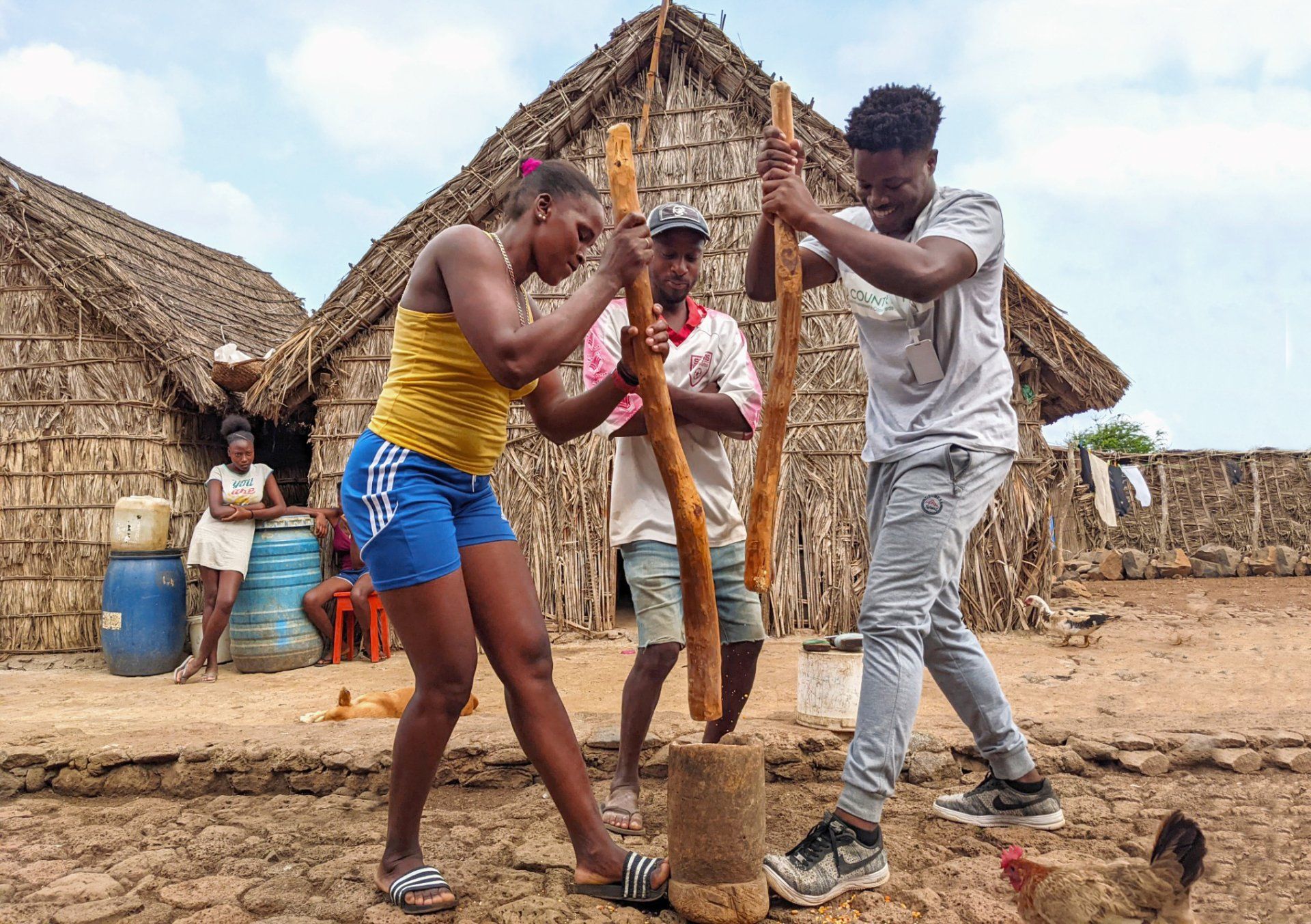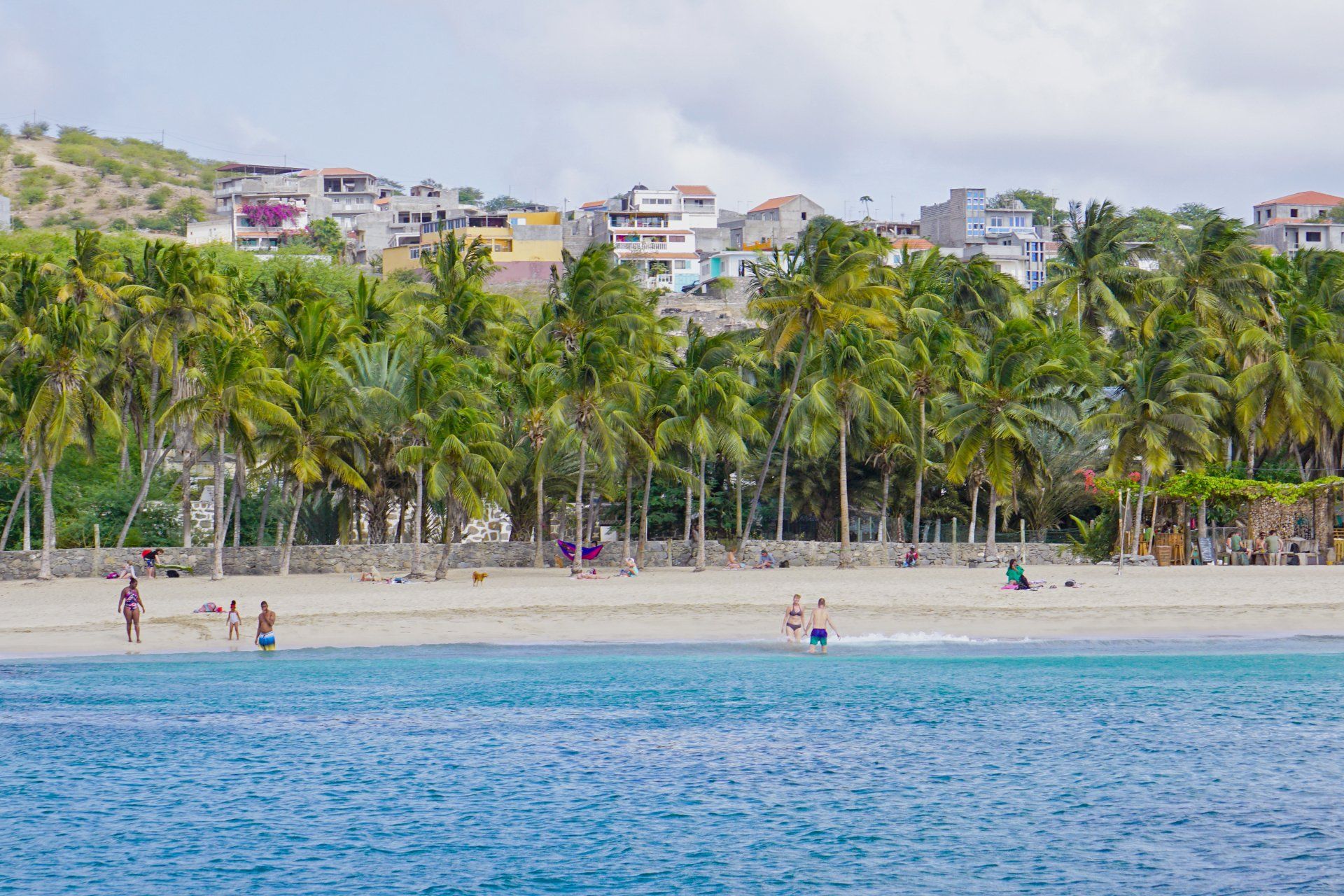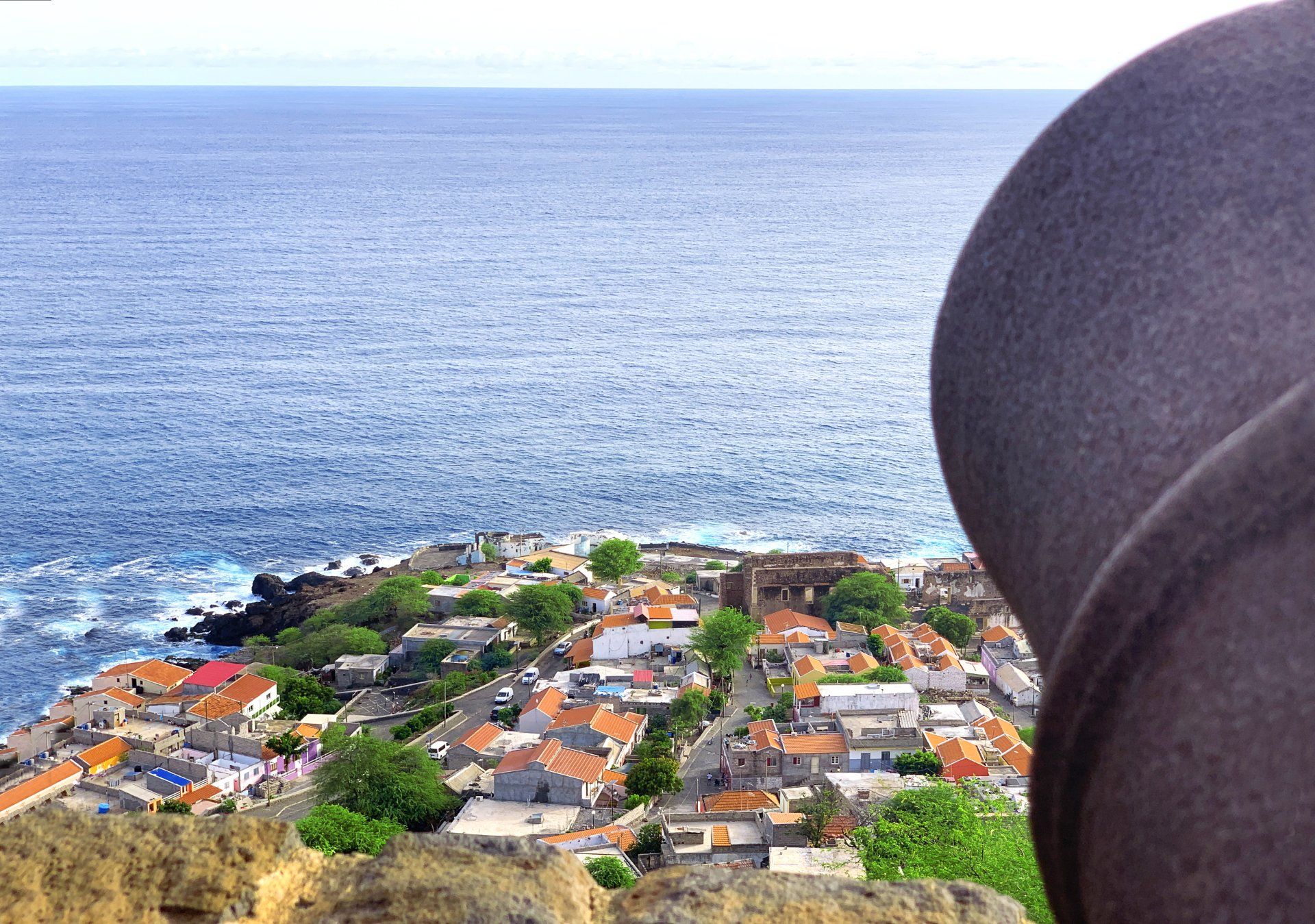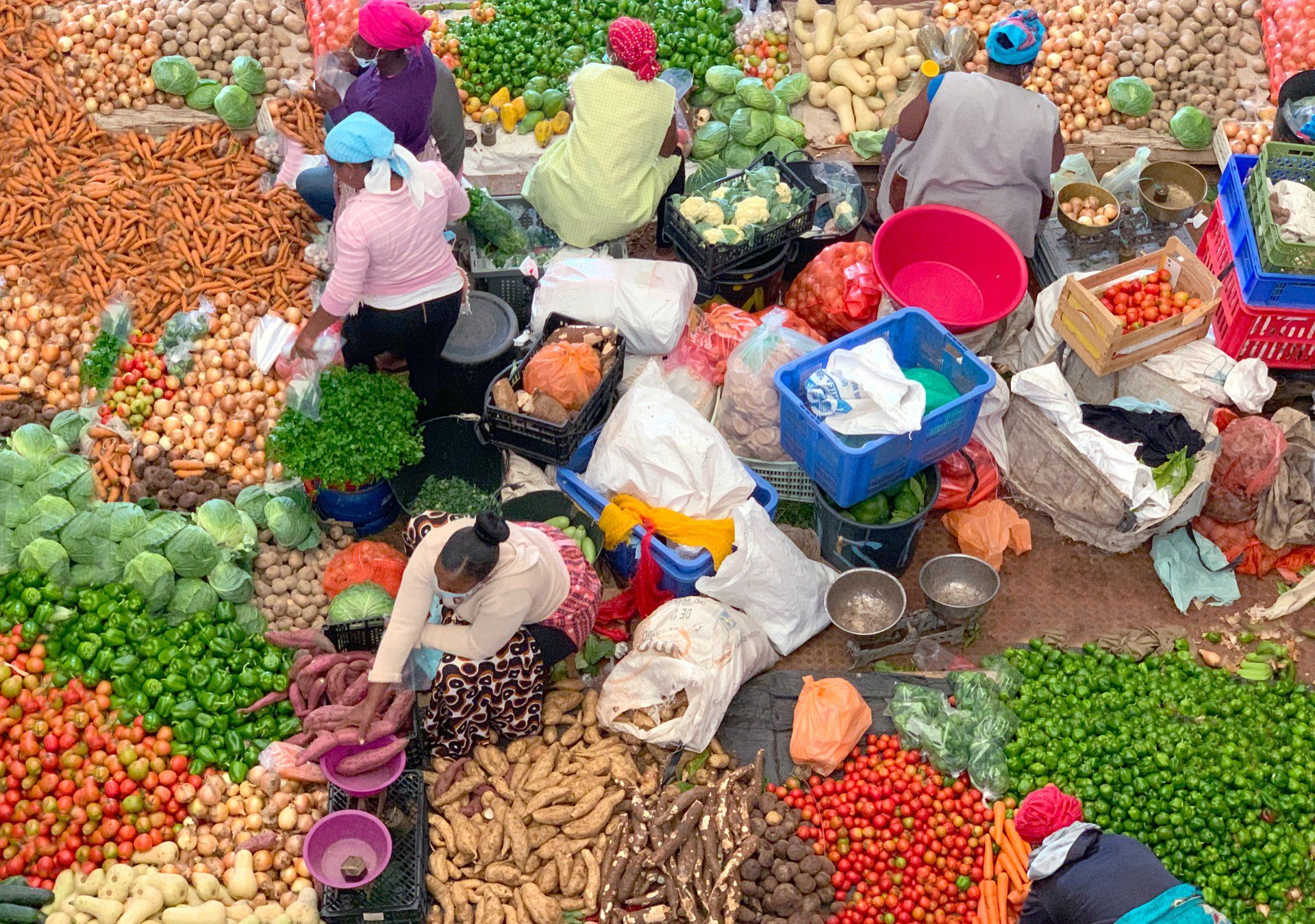Praia is both the country's capital and its most populous city. The island of Santiago and Praia have experienced extraordinary development since independence in 1975, with the population doubling since that year. One of the oldest settlements is São Domingos, in a valley of the same name in the interior of the island.
The island has the recently expanded (November 2005) Praia International Airport, with a runway 2,100 meters long by 45 meters wide, altitude 70 meters MSL (Mean Sea Level), international code "RAI". Located only 3 km from the city center, the airport receives international flights from Europe (Lisbon, Paris, Amsterdam, Munich), South America (Fortaleza, Brazil), North America (Boston) and the African continent, in addition to domestic flights.
Ribeira Grande de Santiago, formerly Cidade Velha, 15 km west of Praia on the coast, was the first capital of Cape Verde.
About 50 km north of Praia is the town of Assomada with its crowded market and the Tabanka Museum. North of the island, about 75 km from Praia, is the town of Tarrafal, a beach of white sand and palm trees, with some tourist facilities. In the same municipality is the former Tarrafal Camp, created by the Portuguese government of the Estado Novo under Decree-Law no. 26 539, April 23, 1936.
The variant of Cape Verdean Creole spoken in Santiago receives the popular name of badiu, a term also used to designate the native of that island.
Itinerary
The island of Santiago, the largest of the Cape Verde archipelago, with its almost 1,000 km2 and more than 300,000 inhabitants, brings together a palette of natural charms, historical treasures, and cultural riches that we will find throughout the country.
Here we can go to pleasant beaches, live in luxuriant landscapes, some of them almost lunar, travel back in history to the times of piracy and the slave trade, feel the cosmopolitan or rural warmth, climb abrupt peaks or lose ourselves in green valleys, feel the African and tropical essence in typical markets, in unforgettable flavors, in handcrafts, in unique music that goes around the world from here.
Here is the cradle, once called Ribeira Grande, now known as Cidade Velha. The silence and peace of today contrast with the early days of European penetration in the African tropics through what was the first capital of the archipelago, and the first city founded in Africa by the Portuguese.
In Cidade Velha, the memories left by the discoverers and settlers merge, remaining some relics, almost all in ruins, and houses built on stone walls, sometimes covered with thatch, and the luxuriant vegetation of the valley that was formed here, especially the coconut trees and the imposing calabaceiras.
The Fortress of S. Filipe was built with Portuguese and Mayan stone, and in its time defended the city from foreign greed, responding to what, in the five hundred, six hundred and even seven hundred years, were the constant attacks of famous corsairs such as Francis Drake and Jacques Cassard. Ribeira Grande was then a customs center for ships transporting slaves from the coast of Africa to the rest of the world. From those times there still remains the Church of Senhora do Rosário, with its tombs and tiles reasonably preserved. The Sé Cathedral, whose ruins were stabilized through a project by the famous Portuguese architect Siza Vieira, is still awaiting a plan for its restoration. The Manueline-style pillory, erected in 1520, bearing witness to the violence to which slaves were publicly subjected, is one of the few intact pieces of architecture in the city of Ribeira Grande.
Permanent instability meant that in 1769 the capital of the archipelago was transferred from Ribeira Grande to the more secluded Cidade da Praia. Time then became the great master of Cidade Velha.
Praia is an urban piece of Africa in the Atlantic waters. The city seems to pulse from the Praça Alexandre de Albuquerque, a space where those who circulate on the Plateau cross between the commerce and the institutional and religious buildings that surround it.
In recent decades, the capital jumped off the Plateau and built several neighborhoods, some of which, such as Achada de Santo António, Palmarejo, Cidadela, Achadinha, Achada Grande, and Achada de S. Filipe, are now important and infrastructured settlements, attracting an important part of the city's life, whether in terms of commerce, decentralizing the Administration, or in terms of nightlife, gastronomy, or cultural and sports offerings.
A visit to the Plateau Municipal Market is a must, recently remodeled and expanded, where the agricultural products from the center of the island are brought in an eagerness of saleswomen carrying in their buckets, invariably taken from noisy Hi-Aces, the papayas, bananas, mangos, cassava, tomatoes, tamarind, coconuts, vegetables, and other delicacies that the great city is supplied with for daily cooking.
Sucupira, on the other hand, is a market-restaurant with a response to the most varied consumer needs, from clothing and shoes to various services, and also fruit and vegetables, which has been strongly established over the last 20 years in the valley that separates the Plateau from Achadinha, upstream from Tahiti.
A product of the capital's astonishing expansion, Avenida de Lisboa, on its way to the Government Palace to the south, and demanding Bairro de Vila Nova to the north, has become the new axis of the city, an obligatory passage to enter or leave.
From Praia is the already famous choreographic group Raiz di Polón, whose performances are an attraction of very good artistic level.
As for the visitor, he can choose to take a dip in beaches such as Quebra Canela, Prainha, Mulher Branca or Gamboa.
Gamboa, a beach little used for bathing, where the small landing jetty that served even the passenger liners in the last century still exists, attracts practitioners of various sports disciplines at the weekend, but has become known for several years for the Festival that took its name, and usually takes place in May, attracting to the beach sounding names of international music.
The entire riverside area of Praia, from the port to Cidade Velha, is in a process of requalification that in the medium term will completely transform the southern seafront of the island.
The night in Praia is a time of many choices. From the enticing flavors of the varied gastronomy to the vertigo or dolence of a music deeply rooted in the soul of a people. These are unforgettable moments of conviviality with a comforting cultural richness. The nights at the Quintal da Música, on Amílcar Cabral Avenue, or at Fogo d'África, in Terra Branca, are examples of this, especially when a group of drummers shake their hips in the frenzy of this typical Santiago singing, an inheritance from the distant but strong continental roots of the Cape Verdean population, or the violin of the great artist Nhô Náni echoes giving rhythm to the dance?
We leave Praia heading north. Before we get lost in successive mountainous slopes where the shapes of the peaks that top them are a challenge to everyone's imagination, the stop in S. Domingos shows us one of the richest and greenest valleys on the island that invites us to look for Cape Verdean souvenirs in the Center of Support to Popular Production.
S. Jorge de Órgãos, next, is the contrast with the roughness of the mountain slopes. Here, in the encounter and quiet of the dense vegetation, we can visit the only Botanical Garden in the country. It is at the foot of Santiago's highest elevation, the Pico da Antonia.
And if the visit takes place in the last quarter of the year, after the brief rains, the traveler can be sure that the vegetation will be luxuriant.
Up there, in Rui Vaz, is one of the island's most frequented restaurants, served by Quinta da Montanha, a rural unit that is dedicated to agriculture using the latest irrigation and product selection technologies.
On the opposite side of S. Jorge, to the northeast, at Ribeira de Poilão, is now the first major dam built in the country, in 2006, to harness rainwater. After a decade of operation, the fertile fields rising from the banks are visible, overflown by flocks of white herons and wild pigeons.
More dams have since been built and promise to revolutionize agriculture on several creeks, such as Flamengos, Salineiro, Saquinho, Figueira Gorda, and Faveta. As soon as there is rain that supplies them, during the "aságua" period.
The little bird, a small bird of bright colors, endemic to this island, to Fogo and Brava, has since multiplied its presence, flying between the branches of the bushes around the water basins. It is also remarkable the contrast of this island before and after the rains, which between July and October, in sparse periods but usually in massive doses, cause floods in the streams and coat the entire surface of this land with green, which, however, in the first months of the year, returns to its usual dryness.
A little more than 60 kilometers from Praia, the city and the countryside mix in the very special atmosphere of Assomada. The town market is one of the most important commercial centers in the country, especially for agricultural products. People converge here from all over the highlands, both to sell and to buy. It is a few kilometers from this large urban center, in Chã de Tanque, that you can visit the Tabanka Museum.
Further on, past the central plateau of the island, fertile and colorful, an escape to the southwest coast, for a look at two of the many "little ports" of the island: Porto Rincão and Ribeira da Barca, fishing villages.
Far to the north, past the Serra da Malagueta, a privileged viewpoint over the Ribeira de Principal, you reach a place of contrasting emotions: Tarrafal.
The bay is a paradisiacal place, with clear sands, tepid and crystalline waters, welcoming shades of imposing coconut trees. What beach lovers have always dreamed of. It is also a very important place for fishermen, who do their work here.
The contrast with the natural beauty is embodied by the site of the old prison built in the second quarter of the last century by the dictatorial regime then in force in Portugal, and where political and common law prisoners were imprisoned, either from the then Metrópole, or from the Portuguese Colonies at the time. A small museum bears witness to the saga of some of these prisoners, who cannot be forgotten.
After another magical encounter with traditional gastronomy, where cachupa, a consistent dish based on corn, beans, vegetables and various meats or fish, is queen, we begin the return trip along the northeast coast.
The landscape has changed. The road follows small bays and coves, tiny deserted beaches of black sand where fishing boats occasionally rest. In small creeks, as if alternating, agricultural lands are discovered stretching out to the sea. The Ribeira de Principal, past Mangue das Sete Ribeiras and before we reach Chã de Monte, is a fertile vein of intense agricultural life.
We then find some villages of unsubmissive peasants who isolated themselves in a kind of protest against what they considered to be the surrounding distortion of the principles of life they believe in. They are the Rabelados. They still consider themselves Christians, but they have moved away from the concepts of the official religion. They were therefore considered subversive, and as such were subject to the distrust of both the Catholic Church and the Established Power. They believed in the new times of Independence, but these hopes were followed by phases of disillusionment. They closed themselves off again, and although there are new signs of openness, the Rabelados still cling to their principles, tending to become fewer and fewer as new generations become educated.
After passing one of the most important villages of the island, S. Miguel da Calheta, we arrive at Santa Cruz, where in the past there were extensive and inviting plantations of banana, coconut and papaya trees in a luxuriant area followed by an impressive gorge. A walk along the Ribeira de Santa Cruz takes us to the heart of what the island was in centuries past, to Ribeirão Boi and Salto, near Santa Catarina, where we dive into the deep history of the construction of the Creole people and language.
Santiago de Pedra Badejo is also a throbbing village, with its fishing port, followed by an extensive plantation of coconut, manioc, banana, sugar cane, and other crops, ending in an extensive black sandy beach bordering the sea, always present and lacy with white foam on the black basalt of the northern coast of the island.
About 15 kilometers from Praia, Praia Baixo is an invitation you can't refuse to meet again with the tepid and transparent waters. Not long ago almost deserted, the stretch of southeastern coast near the capital is now the object of tourist real estate resort projects, some of which are already built or have infrastructure, such as Sambala, near São Francisco, while others are on the drawing board, such as in the counties of S. Domingos, Santa Cruz, and Santa Catarina, still on paper.
A ring road connecting the airport to Trindade and S. Martinho Grande is now a master axis in the urban development of the capital of Cape Verde, and allows traffic coming from the interior or from the airport to choose to go east, to the center or west of the city, or even to the newly urbanized area of S. Francisco.
The Praia International Airport took the place in 2005 of the runway that until then could only accommodate small aircraft, which guaranteed internal traffic, as well as some connections to nearby cities on the mainland.
The expansion of the airport facilities is currently being concluded, facilitating the movement of economic and political agents, the world of culture and tourism, and the population in general.








